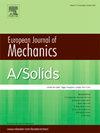Assessment of mixed-mode I/II fracture behavior of blunt V-notched 3D-printed PLA specimens: A strategy of material simplification using VIMC and EMC
IF 4.2
2区 工程技术
Q1 MECHANICS
引用次数: 0
Abstract
Fracture behavior of square plates made from Polylactic Acid (PLA) using Fused Deposition Modeling (FDM), containing rounded V (RV) notches, is analyzed under diagonal tensile loading. This study examines the influence of notch geometry, specifically the opening angle, orientation, and tip radius on the structural load-bearing capacity. Fracture load predictions are performed using the Mean Stress (MS) and Maximum Tangential Stress (MTS) criteria by taking advantages of a strategy of material simplification that employs the Virtual Isotropic Material Concept (VIMC) and the Equivalent Material Concept (EMC). The results indicate that notch geometry significantly affects fracture strength. Plates with larger opening angles show reduced stress concentration and improved fracture resistance, while narrower angles lead to higher localized stresses. Similarly, increasing the notch tip radius enhances fracture resistance by promoting more favorable stress distribution. Compared to conventional brittle polymers such as cast Polymethyl-methacrylate (PMMA), 3D-printed PLA demonstrates reduced sensitivity to notch-induced stress concentration, attributed to its relatively large characteristic length. Scanning Electron Microscopy (SEM) analysis reveals a transition from ductile to brittle failure mechanisms as the notch angle increases. These findings highlight the importance of optimizing notch geometry and raster orientation to improve the mechanical performance of FDM-fabricated PLA parts. The combined application of VIMC and EMC with MS and MTS criteria provides a reliable and practical framework for predicting fracture in 3D-printed structures, without the need for complex anisotropic modeling.
钝型v形缺口3d打印PLA试件混合模式I/II断裂行为评估:基于VIMC和EMC的材料简化策略
采用熔融沉积模型(FDM)分析了含圆形V (RV)缺口的聚乳酸(PLA)方形板在对角拉伸载荷作用下的断裂行为。本研究考察了缺口几何形状,特别是开口角度、方向和尖端半径对结构承载能力的影响。断裂载荷预测采用平均应力(MS)和最大切向应力(MTS)标准,利用材料简化策略,采用虚拟各向同性材料概念(VIMC)和等效材料概念(EMC)。结果表明,缺口几何形状对断裂强度有显著影响。开角越大,应力集中程度越低,抗断裂能力越强,开角越窄,局部应力越高。同样,增加缺口尖端半径通过促进更有利的应力分布来提高抗断裂能力。与传统的脆性聚合物(如铸造聚甲基丙烯酸甲酯(PMMA))相比,3d打印PLA由于其相对较大的特征长度,对缺口引起的应力集中的敏感性降低。扫描电镜(SEM)分析显示,随着缺口角度的增大,材料的破坏机制从延性向脆性转变。这些发现强调了优化缺口几何形状和光栅方向对于提高fdm制造PLA零件的机械性能的重要性。VIMC和EMC与MS和MTS准则的结合应用为3d打印结构的断裂预测提供了一个可靠实用的框架,而无需复杂的各向异性建模。
本文章由计算机程序翻译,如有差异,请以英文原文为准。
求助全文
约1分钟内获得全文
求助全文
来源期刊
CiteScore
7.00
自引率
7.30%
发文量
275
审稿时长
48 days
期刊介绍:
The European Journal of Mechanics endash; A/Solids continues to publish articles in English in all areas of Solid Mechanics from the physical and mathematical basis to materials engineering, technological applications and methods of modern computational mechanics, both pure and applied research.

 求助内容:
求助内容: 应助结果提醒方式:
应助结果提醒方式:


